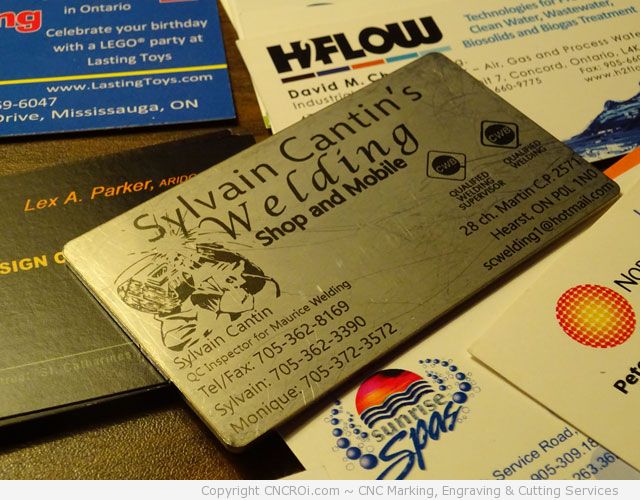304 Stainless Steel vs 316 Stainless Steel
I’ve been mentioning here on CNCROi.com that we can cut and anneal 304 Stainless Steel as well as 316 Stainless Steel but I’ve had a few inquiries as to what the difference is between the two so let’s do a quick review.
Before I get started though, keep in mind that there are a lot more types of Stainless Steel, each with a slight mineral and metal content, the more exotic the mix, the more expensive and difficult to source meaning, you got to order MORE for a lot MORE. There are also a number of different finishes you can get with Stainless steel both from the foundry itself or applied in the shop on a per project basis.

I scratched this card on purpose with another blank, the annealing stayed on… this is one tough business card that can be welded just about anywhere and can live-up to even the toughest networking environments. 304SS, 1.6-1.8 mm (0.06-0.07 inches) thick.
What is Stainless Steel?
Stainless Steel is a steel alloy with at least 10.5% chromium by mass and is more corrosion, rust and stain resistant than typical metal. In this case, 304 Stainless Steel is the typical steel used in most non-marine or hazardous environments where the extra cost of 316 Stainless Steel, which is more apt to those environments, isn’t required. To put it simply, 316 is more resistant to environmental corrosion than 304 due to the extra molybdenum content in it which also increases the price, it actually has less chromium than 304.
Stainless Steel Properties
In Stainless Steel, the chromium and molybdenum content form a thin layer on the surface which gives it a smooth finish that’s water and air proof but when a scatch is made, the material is open to corrosion though the layer reforms itself quickly. This is why it’s important if you are cutting Stainless Steel using a laser to use Nitrogen as it protects the open surface from gall (torn uneven surfaces) which takes the metal that much longer to reform the thin protective layer.
Dependent on the environment, 316 Stainless Steel might be preferable as it’s more resistant to phosphoric acid while 304 Stainless Steel is more resistant to sulfuric acid though hydrochloric acid will corrode most Stainless Steel types. This is why the environment your plaque will be located within will have a direct bearing on which grade or type of Stainless Steel we’ll use here at CNCROi.com to make your industrial plaques and tags.
If you plan on being rough with your Stainless Steel, 316 is weaker and not as absorbing to energy as 304 has a greater ability to deform without breaking and yes, you can actually get magnetic Stainless Steel.
What does this all mean?
Generally, for most applications, even light marine or hazardous environmental use, 304 is fine unless you are advised otherwise. Whether it’s in the back of machines to indicate serial numbers or as awesome business cards, 304 is more than fine.
What are the annealing results on 304 Stainless Steel?
See for yourself, in this case, a 4 kw CNC laser with nitrogen cut this blank and then it was passed over it with a fiber laser. Why fiber? It’s more efficient, environmentally friendly and operator healthy than using alternatives such as Cermark which is a toxic ceramic paste. The quality from using a fiber is far superior to Cermark from angle of view to durability.